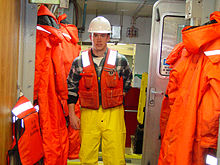Life vest
A life vest (also called Personal flotation device, lifejacket, or cork jacket) is a special type of clothing. The vest makes people float in water. It also keeps their head out of the water so that they can breathe. There are different categories of life vests. They are mainly different in how much flotation they provide. Some life vests inflate all by themselves, others need to be filled with air manually.





A life vest has one very important property: The part of keeping the head outside the water works even if the persion is unconscious, or unable to do anything. A swimming aid will simply help the person in the water, and make swimming easier. It will not work on its own.
People doing watersports, for example sailing, usually wear life vests.
Types
changeThere are two broad categories of life vests:
- Those that are worn all the time, sometimes over clothing. Here, the design goal is also that wearing them is moderately comfortable. Example users are sailors, and people doing certain water sports. This use is called preventative.
- Those that are only worn on occasion: For example, those on planes, or on passenger ferrries. Usuallly they are designed so that they are easy to use (and quick to put on). This use is called interventative.
Life vests are also classified by the minimum and maximum supported weight, which is usually printed on the vest. For this reason, there are special life vests for children. Also note, that the simplest types of life vest usually do not support the person wearing it becoming unconscious (and still guarantee that the person is in the right position, and the head is outside the water).
To be safe even for unconscious people, these vests must bring the wearers to lie on their back. For adults, this means that they must have a flotation of at least 230 Newton. Note that even with such vests, this can usually not be guaranteed: The wrong angle of hiting the water surface, or the position of arms and legs can prevent it.